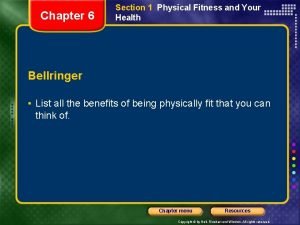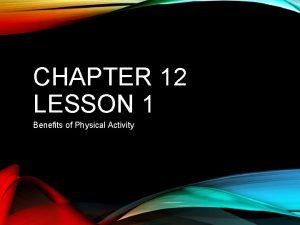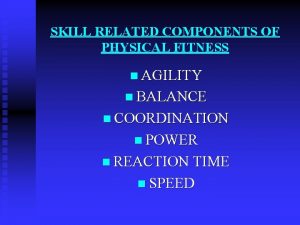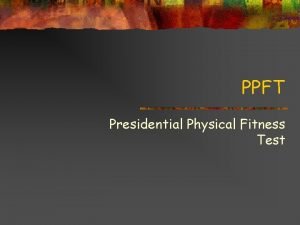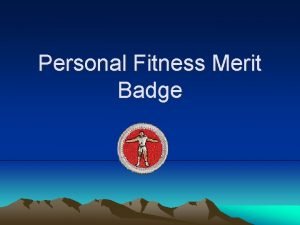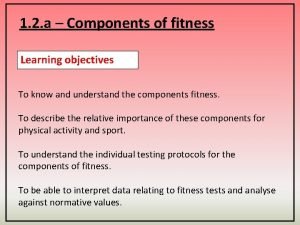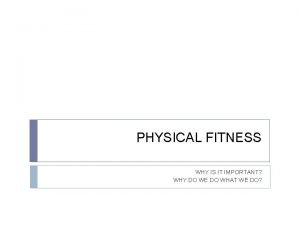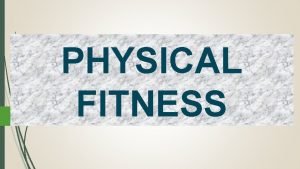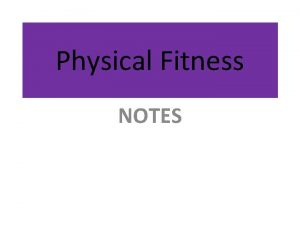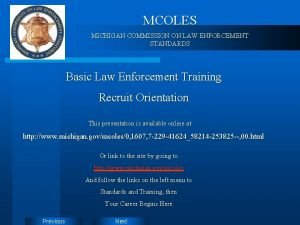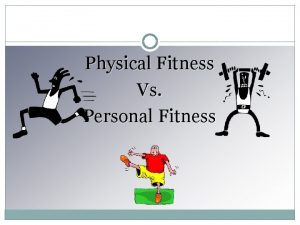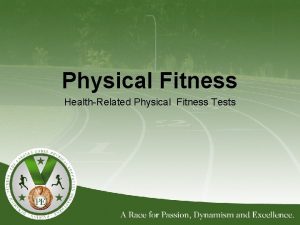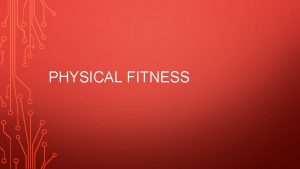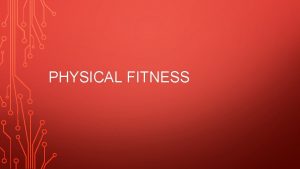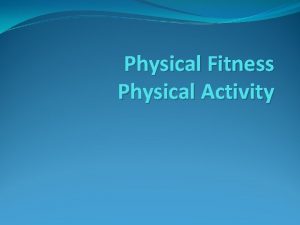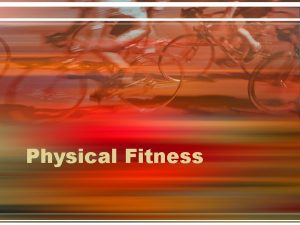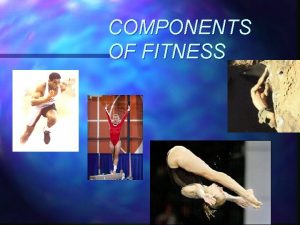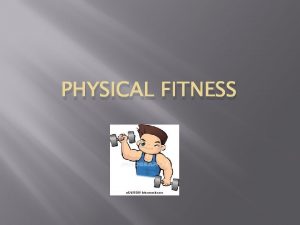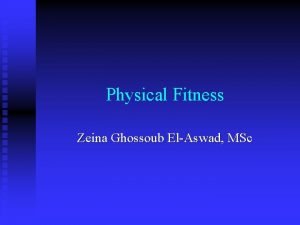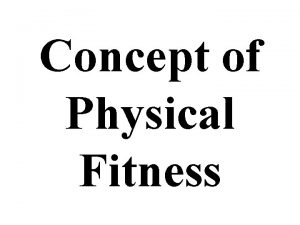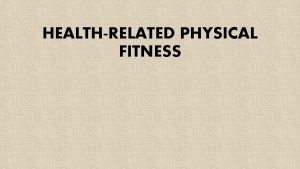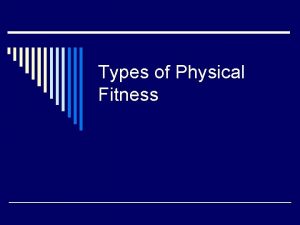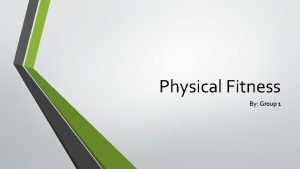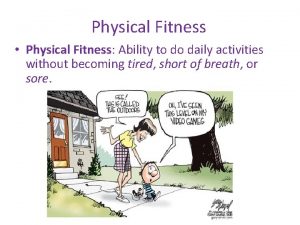PHYSICAL FITNESS and YOU What is Physical Fitness



















- Slides: 19

PHYSICAL FITNESS and YOU

What is Physical Fitness The ability to carry out daily tasks easily and have enough reserve energy to respond to unexpected demands.

Benefits Physical Health ü Reduces chances of acquiring diseases (such as…) ü Higher energy levels for longer periods

Benefits Mental/Emotional Health ü Intellectually more productive ü Relief from stress and control depression ü Contributes to positive self-esteem

Benefits Social Health ü Reduces stress that interferes with good relationship ü Makes you more able to deal effectively in social situations (ex: meeting new people) ü Opportunity to interact and cooperate with others

Components of Physical Fitness Body Composition-ratio of body fat to lean body tissue (muscle, bone, water, etc. ) Flexibility-ability to move a body part through a full range of motion Muscular Strength-amount of force a muscle can exert Muscular Endurance -ability of the muscles to do difficult physical tasks over a period of time without causing fatigue Cardiorespiratory Endurance- Ability of the heart, lungs, and blood vessels to send fuel and oxygen to the body’s tissues during long periods of vigorous activity

Measuring flexibility Use the following techniques to measure your flexibility: ü Touch your bent knees to your chest ü Palms on the floor while standing ü While sitting twist at the waist until your shoulders are perpendicular to your feet

Measuring the components of physical fitness Body Composition- skin-fold calipers Muscular Strength- push-ups or situps Muscular Endurance- sit-ups Cardiorespiratory endurance- 3 minute step test, or mile run`

Improving the components of physical fitness Cardiorespiratory Endurance Ø Aerobic Exercise: vigorous activity in which oxygen is continuously taken in for a period of at least 20 minutes. (Examples…) Muscular Strength, Endurance, and Flexibility Ø Anaerobic Exercise: intense bursts of activity in which the muscles work so hard they produce energy without using oxygen. (Examples…)

Three Types of Resistance Training Isometric Exercise- activity that uses muscle tension to improve muscular strength with little or no movement at all. (Ex: pushing against a wall, or your own body) Isotonic Exercise- activity that combines muscle contraction with repeated movements. (Ex: push-ups, pull-ups, lifting weights) Isokinetic Exercise- activity that involves resistance through an entire range of motion. (Ex: pushing or pulling against a lever or exercise equipment)

Exercise and Weight Control One in three American adults, and one in five teens are overweight or obese. Overweight is related to two concepts: Ø Metabolism- process by which your body gets energy from food Ø Basal Metabolism- minimum amount of energy required to maintain the life processes in a body

Six factors that affect your exercise program Where you live Your range of interests Time and place Personal safety Comprehensive planning (picking activities that address all five health-related fitness components)

Basics of an exercise program Progression- pushing your body harder than it is normally worked. Overload- gradual increase in overload necessary for achieving higher levels of fitness. Specificity- particular exercises and activities improve particular areas of health -related fitness.

Three stages to a work-out Warm-Up Workout (FIT Principle) Cool Down

FIT Principle Frequency- how often you do the activity each week. Intensity- how hard you work at that activity each session. Time- how long you devote to each session.

Heart Rate Resting heart rate- number of beats per minute while you are not active. Maximum heart rate- number of beats your heart can with stand per minute. Target Heart rate- the range in which your heart rate should be during exercise.

Target Heart Rate To find your maximum heart rate: your age and subtract it from 220. Find your resting pulse for one minute (carotid artery, radial artery for 30 seconds x 2) Use 75 -85% for target heart rate

Target Heart Rate 220 - AGE = Maximum Heart Rate (MHR) Resting heart rate subtracted from MHR Multiply your answer by 75% and then by 85% Add your resting heart rate back in Your two values are now your Target heart rate “range”

Exercise Related Injuries Treatment for minor injuries ØR ØI ØC ØE
 Physical fitness test grade 9
Physical fitness test grade 9 Skill related fitness vs health related fitness
Skill related fitness vs health related fitness Physical education grade 7
Physical education grade 7 Two types of physical fitness
Two types of physical fitness Section physical fitness and your health
Section physical fitness and your health Fitness chapter 12
Fitness chapter 12 Glencoe health chapter 12
Glencoe health chapter 12 Tell me what you eat and i shall tell you what you are
Tell me what you eat and i shall tell you what you are Agility skill related fitness
Agility skill related fitness Presidential physical fitness test definition
Presidential physical fitness test definition Personal fitness merit badge answers
Personal fitness merit badge answers Benefits of hexagon agility test
Benefits of hexagon agility test Ruler drop test normative data
Ruler drop test normative data Physical fitness
Physical fitness Physical fitness is defined as
Physical fitness is defined as Definition of physical activity
Definition of physical activity Physical fitness notes
Physical fitness notes What are the 5 components of the fitnessgram
What are the 5 components of the fitnessgram Michigan mcoles test
Michigan mcoles test Phonons of physical fitness
Phonons of physical fitness




